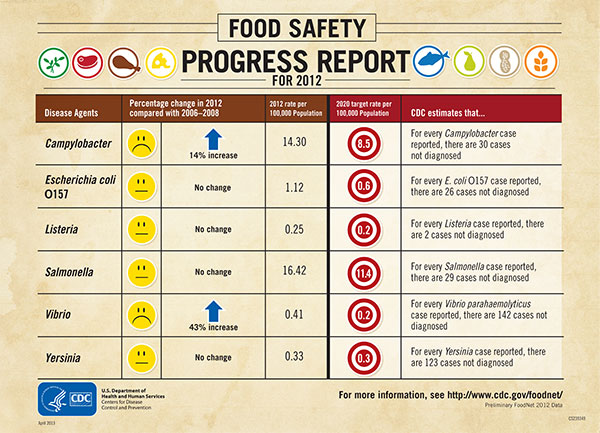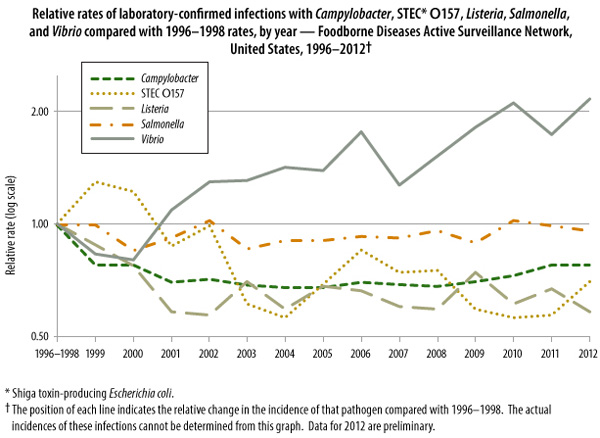The Centers for Disease Control and Prevention (CDC) has released a snapshot of the report card for food safety issued by FoodNet. This data helps public health officials know how much progress (or lack of progress) has been made in reaching goals for reducing foodborne illness.
Those goals, enumerated at HealthyPeople.gov, state that the objectives are to reduce infections caused by bacteria and viruses transmitted through food. More specifically, the government is working toward reductions in infections due to STEC bacteria, Listeria, and Salmonella in beef, dairy, fruit, nuts, leafy vegetables, and poultry. They also want to prevent an increase in the proportion of Salmonella and Campylobacter isolates that are resistant to antimicrobial drugs. Finally, increasing the proportion of consumers who follow food safety practices and improving food safety practices in foodservice and retail establishments are key.
One interesting point in the snapshot is the multiplier that the CDC uses to estimate the number of actual food poisoning cases, based on the lab-confirmed cases that are reported to officials. Those numbers range from 2 for Listeria infections, up to 142 for Vibrio infections.
The chart above provides a stark reminder that the rates of laboratory-confirmed infections with Vibrio and Campylobacter are increasing. In response, Consumer Federation of America (CFA) released a statement saying that the data “demonstrate a need for greater vigilance in efforts to reduce illnesses from these pathogens.”
Salmonella and Campylobacter illnesses are often associated with raw or undercooked poultry. CFA also states that “much of the poultry that consumers purchase in the supermarket is sold as parts, yet the Food Safety and Inspection Service has collected data only on whole birds, not on the level of contamination of poultry parts. Additionally, whole birds purchased at retail and tested by consumer groups have shown unacceptably high rates of Salmonella and Campylobacter.”
CFA is also concerned about the HIMP program that will change the way poultry is inspected in processing plants. They state that, “the agency has almost no data on how the proposed program will actually affect Campylobacter rates on poultry and does not require poultry plants to test for Salmonella and Campylobacter, significantly limiting the agency’s ability to assure that poultry plants are reducing contamination from these pathogens.”
The CDC states that it established performance standards for Campylobacter contamination of whole broiler chickens in processing plants in 2011. It also approved more stringent time and temperature controls for oysters after harvest to prevent Vibrio infections. And the Food Safety Modernization Act of 2011 will help the CDC strengthen surveillance and outbreak response.
Charts provided by the CDC.






